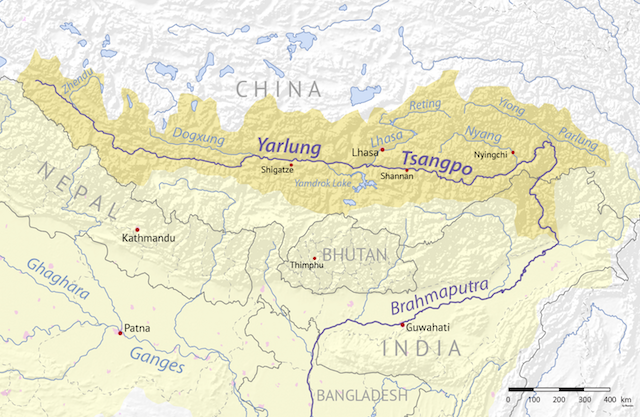
by Nava Thakuria, CounterVortex
The Chinese state’s hydro-electric activities on the Yarlung Tsangpo (or Zangbo) river have long been a source of tension with the downstream countries of India and Bangladesh, which cite a risk of ecological disaster. Now Beijing has started building a colossal dam at the Tsangpo’s great bend in southeastern Tibet, close to the border with the Indian state of Arunachal Pradesh. Chinese Premier Li Qiang on July 19 attended the groundbreaking ceremony for the Medog Hydropower Station in Nyingchi, Tibet Autonomous Region, and hailed it as the “project of the century.” But the $168 billion hydro-dam, which will be the world’s largest when it is completed, is described by Arunachal Pradesh leaders as an “existential threat.”
The Tibetan plateau feeds a number of rivers which support a populace of over 1.5 billion South Asia. The most significant of these is the Yarlung Tsangpo, which is known as the Brahmaputra as it crosses into India, and then as the Jamuna in Bangladesh. Beijing first announced plans for the current mega-project under its 2020 Five-Year Plan, as part of a broader strategy to exploit the hydropower potential of the Tibetan plateau. The plan was fully approved in December 2024, and a new entity announced to oversee its construction and operation, the China Yajiang Group Co Ltd. Once completed and made operational (tentatively by 2033), the project is expected to have a generation capacity of 60,000 megawatts—three times that of the Three Gorges Dam on the Yangtze, which is currently the world’s largest hydropower station.
New Delhi has been monitoring Chinese infrastructure interventions on the Tsangpo/Brahmaputra, and raised the issue with Beijing on different occasions. As a downstream or “lower riparian” country with established user rights to the river’s water, India has conveyed concern over the new mega-project. Delhi’s foreign ministry stressed the need for “transparency and consultation with downstream countries.”
But fears are especially pronounced in Arunachal Pradesh, where the river is known locally as the Siang. The state’s Chief Minister Pema Khandu told the Press Trust of India: “Setting aside the military threat from China, it seems to me that this is a far bigger issue than anything else. It is going to cause an existential threat to our tribes and our livelihoods. It is quite serious because China could even use this as a sort of water bomb… If they suddenly release water, our entire Siang belt would be destroyed.”
On the other hand, if too much water is reserved within China, “our Siang and Brahmaputra rivers could dry up considerably.” He particularly stressed the impact of either scenario on the Adi indigenous tribe, which lives in the riparian zone of the Siang.
New Delhi has even proposed its own dam on Siang to act as a shield against sudden water releases from the Chinese dam. Delhi proposes the 11,000-megawatt Upper Siang Multipurpose Project in Arunachal Pradesh, with an aim of effectively mitigating the potential impacts from the upstream developments.
Bangladesh, in contrast, seems in no hurry to express concern over the hydropower venture. The current interim government in Dhaka recently said it accepts Beijing’s assurance that no water diversion or use for irrigation purposes will be carried out under the project, and hence it should not affect the water flow to downstream countries.
Beijing defends its decision to go ahead with the Medog Hydropower Station as “fully within China’s sovereignty,” and portrays it as part of its push for clean energy development and response to climate change. The Chinese Foreign Ministry in its July 23 statement asserted that the project will help prevent and mitigate disasters along the entire river. As the project was accepted after rigorous scientific evaluations, the statement said, it will not adversely affect the environment, geological stability or water rights in the downstream countries. The statement added that Beijing is committed to cooperation with lower riparian countries on flood prevention and sharing hydrological data.
Earlier this year, President Xi Jinping described hydro development on the Tsangpo as a “win-win solution,” that will reduce pollution and mean economic growth meant for rural Tibetans. However, the project will entail the forcible removal of Tibetan villages. On various occasions, Tibetans both inside and outside Tibet have demonstrated against the practice of damming their sacred rivers by what they view as an occupying imperial Beijing.
The Chinese Communist Party regime occupied Tibet with military might in 1959, following which 14th Dalai Lama escaped to India. The freedom-aspiring Tibetans continue their fight for a genuine autonomy so that they can safeguard their religious, cultural and political rights. However, considering Tibet an integral part of China, Beijing has launched a drive for massive resource exploitation in the region—leading to uncontrolled deforestation, which itself threatens the integrity of watersheds. Although one fifth of Tibet’s land area is recognized as wildlife reserves, those forests are hardly protected in reality.
Hydro-power is the latest push in thie development drive for Tibet—but his declared policy explicitly recognizes that the region’s resources are being exploited for the Chinese heartland. It is dubbed xidiandongsong, or “sending western electricity eastwards.”
Often called the “Water Tower of Asia,” the Tibetan plateau frequently experiences earthquakes, and the latest one was felt as recently as this January 7, with an intensity of 7.1 on the Richter scale, followed by two aftershocks with the magnitude of 4.9 and 5. The temblor, which was also felt in Nepal, Bhutan and eastern Indian localities, destroyed over 3,500 houses in the thinly populated high-altitude Himalayan areas. More than 125 local residents were killed and several others injured, while nearly 30,000 people had to be relocated. After initial denials, Chinese officials disclosed that a few cracks appeared on hydro-dams in Tibet’s Shigatse locality.
In Assam, the Indian state that the Brahmaputra passes through between Arunachal Pradesh and Bangladesh, a forum of engineering graduates, has issued a statement calling on New Delhi to press the question of earthquake risk with Beijing. Warned the All Assam Engineer’s Association (AAEA): “If a high intensity earthquake hits the gigantic Tsangpo project, one can visualize the large-scale impact on the downstream localities covering the entire Brahmaputra river basin.” The AAEA added that New Delhi should deal strongly with the Beijing administration to safeguard the entire eastern region of India from probable disasters.
———
Image: Shannon1/DEMIS Mapserver via Wikimedia Commons
From our Daily Report:
China arrests hundreds as Tibetans protest dam
CounterVortex, March 6, 2024
Tibet: climate struggle frontline
CounterVortex, Dec. 15, 2016
Geography wars in coverage of Tibetan self-immolations
CounterVortex, April 21, 2012
Tibetan village prevails in mining struggle
CounterVortex, Feb. 13, 2012
China: Sichuan quake imperils hydro-dams
CounterVortex, May 16, 2008
Delhi’s suspension of Indus treaty imperils regional stability
CounterVortex, April 26, 2025
Audio:
Podcast: Himalayan fault lines in BRICS
CounterVortex, Sept. 2, 2023
See also:
HOW INDIA COMPLICATED KASHMIR DISPUTE
by L. Ali Khan, Jurist
CounterVortex, August 2019
OUTCAST LAWYERS IN CHINA
by Patrick Poon, Jurist
CounterVortex, May 2018
NEW YORK CITY PROTEST AGAINST EVICTIONS …IN TIBET
by Bill Weinberg, The Villager
CounterVortex, January 2017
CLIMATE CHANGE MIGRANTS OF BANGLADESH
by Mubashar Hasan, IRIN
CounterVortex, December 2015
INDIA: PASSIVE RESISTANCE TO MEGA-HYDRO IN ASSAM
by T Navajyoti, World War 4 Report
CounterVortex, June 2012
Also by Nava Thakuria:
INDIA: OUTCRY AGAINST ‘SPECIAL POWERS’ AFTER NAGALAND MASSACRE
by Nava Thakuria, CounterVortex
CounterVortex, December 2021
—————————-
Special to CounterVortex, Aug. 6, 2025
Reprinting permissible with attribution




